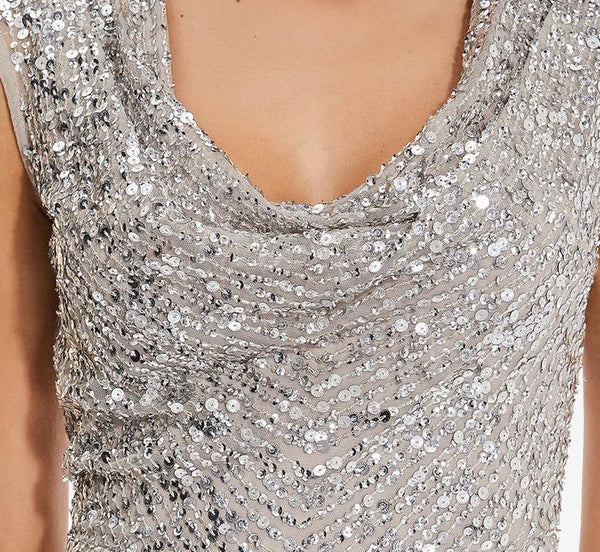Hemming a dress is usually a straightforward process: just pin it to the desired length, trim, press, then sew. When altering a beaded dress, however, things are a little bit more complicated – though not impossible.

How to Hem a Dress With Vertical Rows of Beads
Mark Your New Hem
Take a close look at how the beads are attached. If they’re strung onto the dress in vertical rows, start by marking your new hem: a fabric pencil or chalk is great for this, or if you’re in a bind, a bit of white eyeliner does the trick.
Trim Your Hem
Next, trim the hem approximately four inches from your marked length, so you have plenty of room to slide the beads off the open threads before securing each row with a knot. Tie your knot as close as possible to the last bead but avoid pulling the threads so taut that they bunch up.
Pin the Remaining Hem and Sew it in Place
Finally, pin the remaining hem and sew it in place; you can also trim it first if needed – if the hem itself is very narrow, or you’re working with a sheer or delicate fabric.

How to Hem a Dress with Individually Sewn or Horizontal Rows of Beads
Mark Your Desired Hem
In this scenario, start by marking your desired hem, then use sewing scissors or a stitch ripper to manually remove the beads on both sides of the hem. Be careful to only remove enough beads to give yourself room to sew the new, bead-free hem in place.
Tip: if the beading forms an intricate pattern or design, take a photo of the hem before you remove the beads, as you may want to recreate the design later on.
Sew the Hem in Place
Next, sew the hem as you normally would – by pinning it in place, pressing it if needed, then running it through the sewing machine.
Sew Some Beads Back On
Finally, once you’ve sewn the hem in place, you may wish to sew some of the beads you removed back on. This is a time-consuming additional step, but depending on the intricacy of the beadwork and the sentimental value of the dress (and given you’ve just saved yourself hundreds of dollars in alteration costs), it may be worth it.

A Few Final Notes on Hemming a Beaded Dress
First and foremost, remember that hemming a formal gown isn’t a quick process –you’ll want to spend time on it to make sure you do it right.
Second, you will need some basic tools: a sharp pair of small sewing scissors is essential for getting between each bead. A stitch ripper is also a good option, although some find these a little less precise than scissors. For the hem itself, you’ll need a basic sewing machine, and if you anticipate sewing some of the beads back onto your dress, you’ll also need a needle and thread.
Finally, note the fabric of your dress before you start. Remember that materials such as tulle, silk, and anything with a bit of stretch or elastane can be trickier to work with – beads tend to weigh these fabrics down or pull fibers in different directions. If your dress is made of one of these materials, be sure to pause every few beads or stitches to make sure the fabric still lies flat.
And there you have it: how to hem a beaded dress at home.







